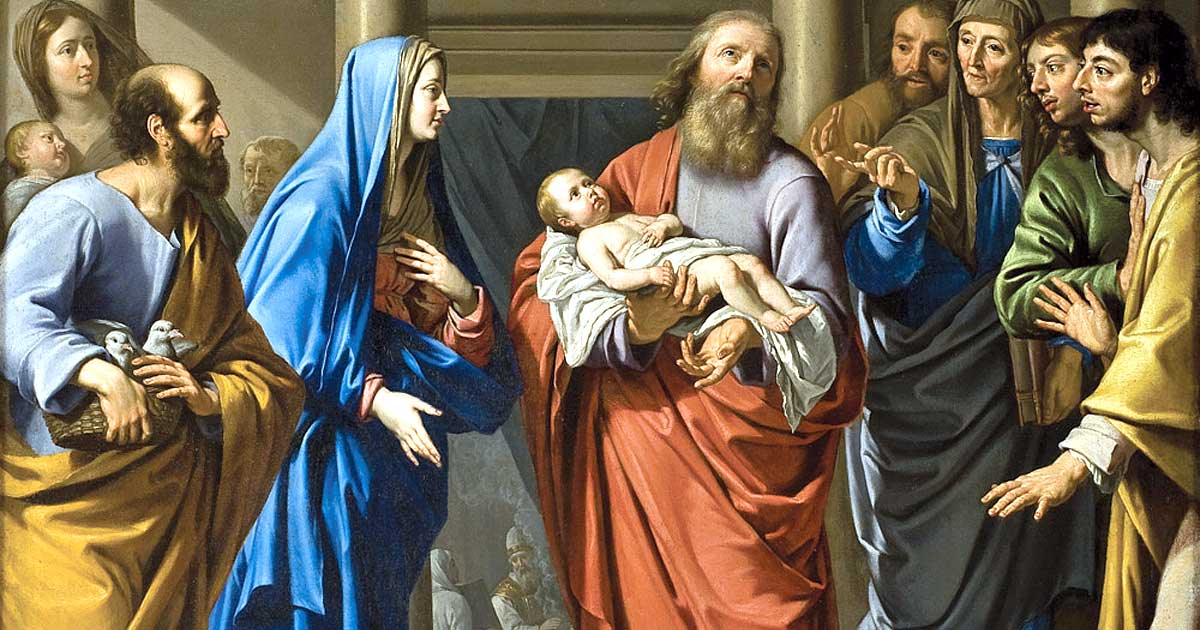WHAT’S IN A CANDLE?
WHAT’S IN A CANDLE?
Every year, forty days after
Christmas, the Church celebrated the Presentation of the Lord. This feast used to be called the Purification
of Mary because the Law of Moses required the mother of a newborn son to make
an offering in the Temple for her ritual purification forty days after giving
birth. A year-old lamb was the
prescribed sacrifice except for those who could not afford it, in which case “a
pair of turtledoves or two young pigeons” could replace the lamb. This is what Mary and Joseph offered. Moreover, the Law also required that the
firstborn male be consecrated to the Lord, even though this did not have to
take place in the Temple (cf. Lk 2,22-24).
Mary had no need to be ritually
purified, having given birth to the sinless Son of God, but she and Joseph were
faithful observers of the Law and fulfilled all its requirements. Perhaps without realizing it, they fulfilled the
prophecy of Malachi: “And suddenly there will come to the temple the Lord whom
you seek, and the messenger of the covenant whom you desire” (Mal 3,1). This was confirmed by the Prophet Simeon, who
took the child in his arms and blessed God, and the Prophetess Anna, who thanked
God “and spoke about the child to all who were awaiting the redemption of
Jerusalem.” The Church observes the
Presentation of the Lord every year with the blessing of candles at the
beginning of the Mass and a procession into the church by the congregation with
lighted candles. The other feast which
calls for the congregation to process into the church with lit candles is the holiest
of all feasts, the Easter Vigil.
Everyone follows the deacon who carries the Pascual Candle, a
consecrated symbol of the risen Christ.
He cries out three times during the procession, “Lumen Christi,” “Light
of Christ,” which shines on our path to heaven.
Candles in the liturgy represent the
light of Christ, which has dispelled the darkness of sin and death. Jesus refers to himself as the light of
the world (Jn 8,12) and also refers to his followers as the light of the
world (Mat 5,15). The lit candles,
then, signify the presence of Christ in the Church and in his people. Saint Paul refers to Christians as “the
temple of the living God” (2 Cor 6,16).
The light of Christ lights up the temple, which is the Church. Before the invention of electricity candles were
used for practical reasons in houses of worship, but they also had a spiritual
connotation, which is why we still use them today. In the second century Tertullian wrote that “We
never hold a service without candles, yet we use them not just to dispel
night's gloom - we also hold our services in daylight - but in order to
represent by this Christ, the Uncreated Light, without whom we would in broad
daylight wander as if lost in darkness.”
St. Jerome affirmed that candles are a sign of Christian joy.
Not every type of candle can be used
in the liturgy. Candles placed next to
or on the altar must be made of at least 51% beeswax and they have to be some
shade of white. Beeswax is the best wax,
made by bees for their honeycombs. It
burns more slowly and has a sweeter scent.
The pure beeswax symbolizes the pure flesh of Jesus, which was taken
from the most pure Virgin Mary. The wick
symbolizes his soul, wrapped in flesh, and the flame symbolizes his divinity. “For our God is a consuming fire” (Heb 12,29). For the sake of the fire a candle sacrifices
its substance, as it slowly burns. In
the union of the fully human and fully divine natures in the one divine Person
of Christ, his flesh was sacrificed for the salvation of the world. No light bulb can symbolize this profound mystery. Therefore, the Church prohibits the use of
electric lights as a sanctuary light or at the altar. Such a use would contradict “the authenticity
and full symbolism of light” according to guidelines published by the US
Conference of Catholic Bishops. However,
oil lamps may be used as a vigil light for the tabernacle, but not at the
altar. Interestingly, the tradition in Eastern
Rite churches is to use lamps fueled by olive oil in addition to candles. When a church is consecrated the bishop
lights the oil lamp in front of the icon of the Crucified Christ, located in
the Bema of the church (the place of the altar). It always remains lit, symbolizing the
perpetual presence of Christ among his people.
He is the light of the world, and his light shines through us, as we
allow the fire of the Holy Spirit to make us less, and to make him more, in the
spirit of St. John the Baptist, who said, “He must increase; I must decrease”
(Jn 3,30).




Comments
Post a Comment